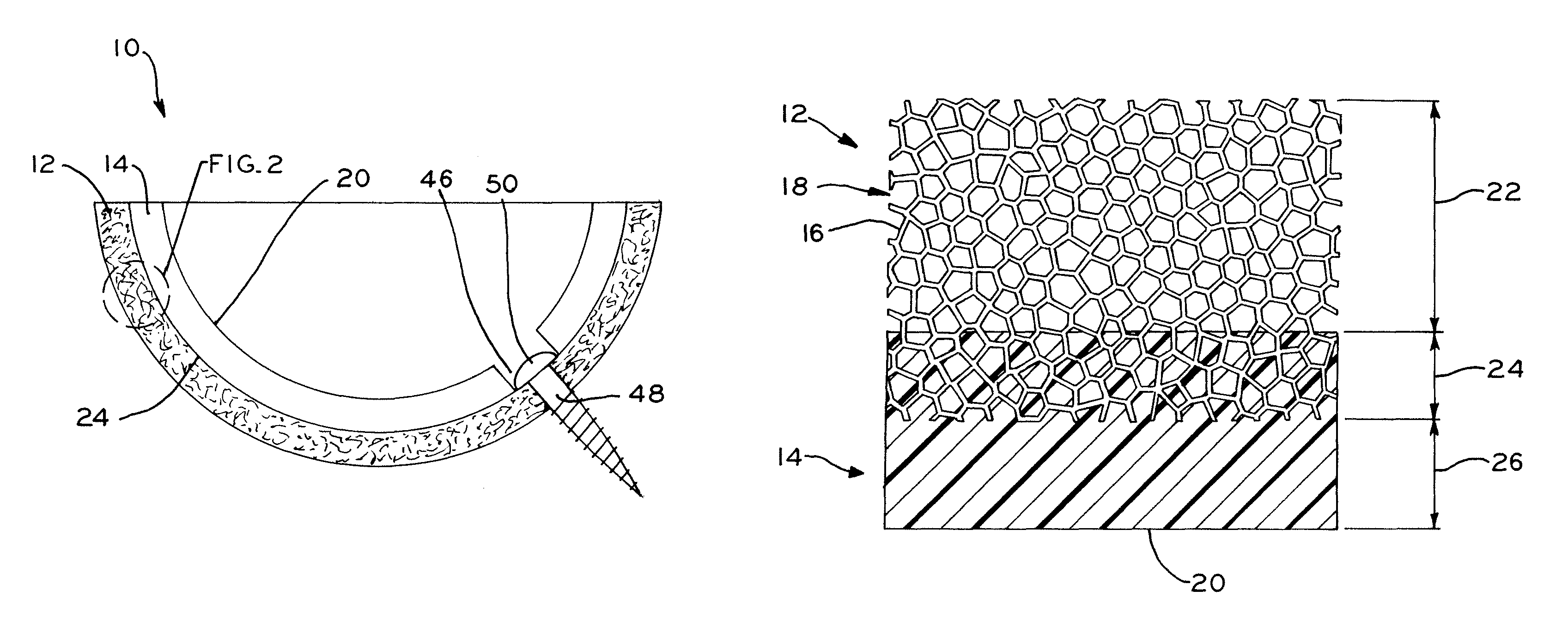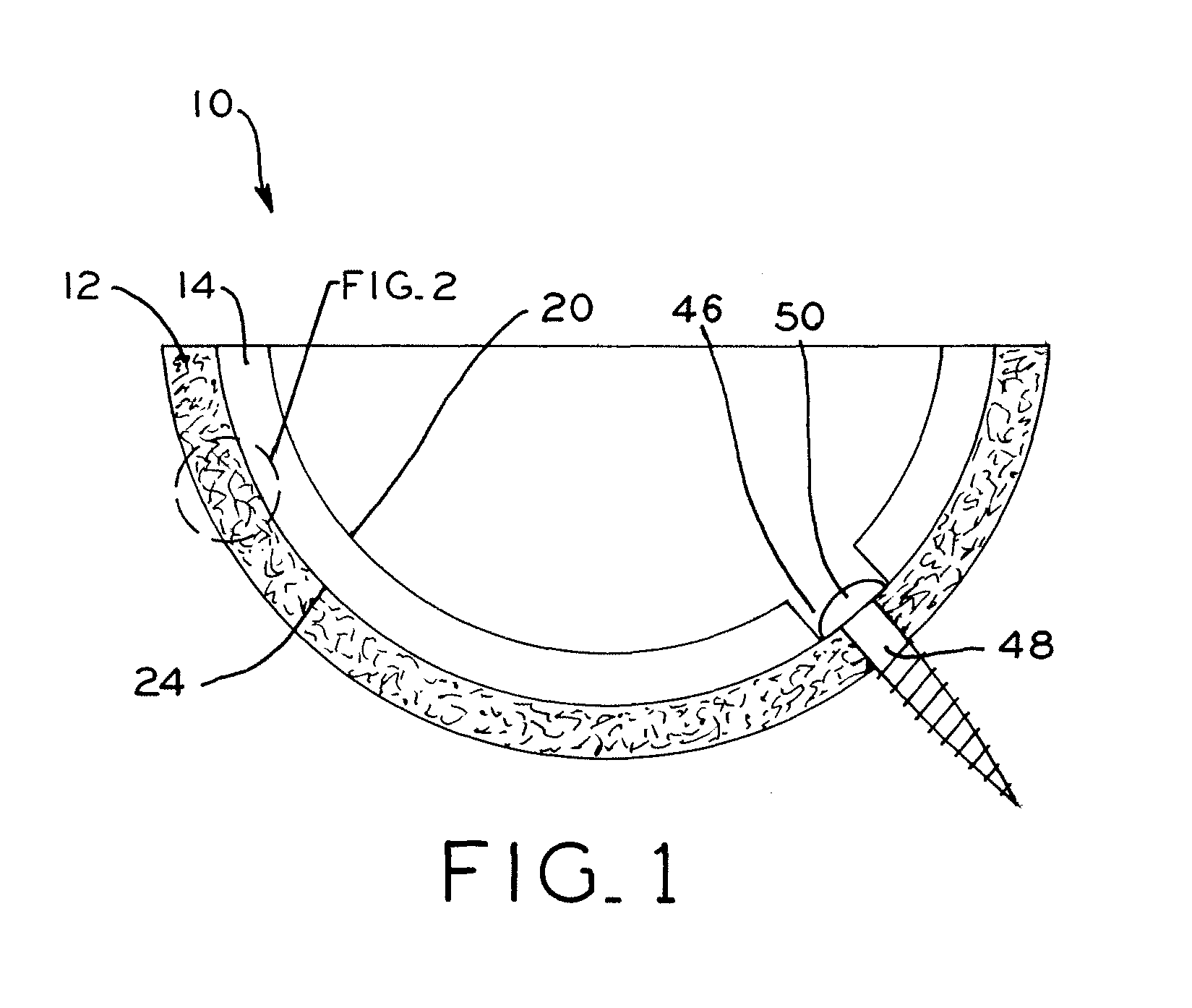Orthopedic component of low stiffness
a low-strength, orthopaedic technology, applied in the field of orthopaedic implants, can solve problems such as weak bone structure, and achieve the effects of reducing the amount of machining steps necessary to finish the orthopaedic component, reducing the effect of stress shielding, and reducing the potential for osteolysis and bone resorption
- Summary
- Abstract
- Description
- Claims
- Application Information
AI Technical Summary
Benefits of technology
Problems solved by technology
Method used
Image
Examples
example 1
Effective Stiffness of PEEK Layer / Porous Layer Construct
[0070]An analytical model was used to study the effective stiffness of a layer of PEEK positioned adjacent to a layer of porous metal.
[0071]The effective stiffness of a layer of PEEK positioned adjacent to a layer of porous metal is dependent on both the material properties and geometries of the individual layers. Thus, to attempt to remove any geometric effects, an analytical model was created to include a rectangular PEEK layer positioned atop a corresponding rectangular porous metal layer. The model incorporated frictionless contact between the PEEK layer and porous metal layer and with none of the PEEK penetrating into the pores of the porous metal layer. Additionally, the porous metal layer is assumed to have properties substantially similar to a porous metal layer formed in accordance with Trabecular Metal™ technology, as described in detail above. The model was then subjected to uniaxial compression. The stress is equall...
example 2
Effects of Acetabular Cup Geometry on PEEK Layer / Porous Layer Stiffness
[0078]A Finite Element (FE) model was used to study the effective stiffness of an idealized acetabular hip cup model having a layer of PEEK interdigitated with a layer of porous metal.
[0079]A 3-D parametric FE model was developed using commercially available FE software ABAQUS 6.7 (ABAQUS, Inc., Providence R.I., USA). The FE model included a femoral component, an acetabular cup, and a bone cement boundary. The femoral component was modeled to be rigid and spherical with a radius, Rfemoral, of 16 mm. The acetabular cup was modeled to have a series of successive layers. The innermost layer is a UHMWPE layer which forms the acetabular liner of the acetabular construct and against which the femoral component articulates. The acetabular shell of the acetabular construct was modeled to have an innermost PEEK layer, an interdigitated PEEK / porous metal layer, and an outermost porous metal layer. The porous metal layer wa...
example 3
Effects of Layer Thickness on a Porous Metal / UHMWPE Orthopedic Component
[0086]A 2D stochastic microstructural FE model was developed to represent an idealized acetabular hip cup having a layer of UHMWPE interdigitated with a layer of porous metal. The internal geometry was based on a 2D random Voronoi structure generated by a custom program in FORTRAN. This program also allows changing parametrically the thickness of the three layers, i.e., the UHMWPE layer, the interdigitated layer, and the porous metal layer, to create different designs. Tantalum microstructs, such as those formed in a material created using Trabecular Metal™ technology, are portions of ligaments 16, shown in FIG. 2a, having a loose end and defining the perimeter of the porous metal layer. These tantalum microstructs were modeled as a bilinear elastic material, as shown in FIG. 7, whereas UHMWPE was modeled as a multilinear elastic material, as shown in FIG. 8. Additionally, the various properties of the UHMWPE th...
PUM
| Property | Measurement | Unit |
|---|---|---|
| thickness | aaaaa | aaaaa |
| thickness | aaaaa | aaaaa |
| porosity | aaaaa | aaaaa |
Abstract
Description
Claims
Application Information
 Login to View More
Login to View More - R&D
- Intellectual Property
- Life Sciences
- Materials
- Tech Scout
- Unparalleled Data Quality
- Higher Quality Content
- 60% Fewer Hallucinations
Browse by: Latest US Patents, China's latest patents, Technical Efficacy Thesaurus, Application Domain, Technology Topic, Popular Technical Reports.
© 2025 PatSnap. All rights reserved.Legal|Privacy policy|Modern Slavery Act Transparency Statement|Sitemap|About US| Contact US: help@patsnap.com



